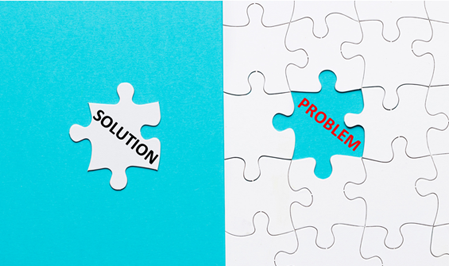Innovation is about solving problems in a unique and beneficial way, but how you approach the problem has significant impact on how successful and sustainable your solution will be.
Too often I see people approach customer pain points or process inefficiencies as well-defined problems—what Gregory Treverton (Risks and Riddles, Smithsonian Magazine, June 2007) calls puzzles, rather than what they really are, ill-defined problems—what Treverton calls mysteries. The distinction between the two is not trivial.
With well-defined problems, we start with a given set of structured, stable conditions or definitions, and work towards a particular end point by following a clear set of rules and a given set of operators or moves. All the parameters are known or can be discovered.
 Inherent with a well-defined problem space is a well-defined solution space. That is, a puzzle is a problem that can be solved. There is only one solution, and the problem solver knows when the solution has been found.
Inherent with a well-defined problem space is a well-defined solution space. That is, a puzzle is a problem that can be solved. There is only one solution, and the problem solver knows when the solution has been found.
For example, jigsaw puzzles, Rubik’s cubes, and the location of your missing car keys are each puzzles with only one definitive solution, even if that solution is reached through different solution paths.
Solving puzzles offers little competitive advantage as everyone with a solution has the same solution.
Ill-defined problems are unstructured, the rules, conditions and definitions are dynamic and even contradictory, and the end point is murky. Only some of the parameters are known. A few more can be discovered.
Inherent with an ill-defined problem space is an ill-defined solution space. That is, not only is the solution unknown, it’s not even clear what form or format a solution might take.
Often with Ill-defined problems you won’t know if your solution was “right” until sometime in the future. The “right” solution today may not be “right” tomorrow. And the “best” solution for one market may not be the “best” in another market.
Solving mysteries can produce significant competitive advantage, because there could be myriad possible and acceptable solutions. Some better. Some worse. Raising the possibility of your solution being unique.
The biggest stumbling block comes from approaching something as a puzzle that is really a mystery. Most customer pain points are mysteries and the methods for solving them are different from those used to solved puzzles.
We tend to look for one breakthrough idea—a magic bullet—that will definitively, effectively and permanently solve the problem. This method fails because that one idea is assumed to be THE solution to a static puzzle, rather than A solution to a dynamic mystery.
To address ill-defined problems:
- Recognize that you’re solving a mystery—an incomprehensibly complex and messy issue that is as difficult to define as it is to resolve.
- You can never know everything about the situation, but you can gain greater empathy for it. Through immersion you can compassionately feel what it is like to be impacted by the problem being addressed, and, therefore, better understand it—preferably at the level of root causes and drivers.
- Endeavor to gain clarity on the ideal end state—the desired outcome—and work towards it.
- With better understanding you’re more likely to develop a solution that fits your customers’ perception of the challenge, and that satisfies your customers’ needs in a way that alternative solutions do not.
- Any solution you discover has a built-in expiration date, so frame your quest as looking for a temporary resolution to improve the situation within a certain context and period of time, rather than try to definitively solve it.
Every customer pain mystery is an opportunity, though not all opportunities are the same, nor are they all worth pursuing. It is prudent to only address those opportunities that also address your organization’s desired outcomes, with a goal of prioritizing those opportunities that offer the biggest impact. Identifying the most valuable mysteries to solve lets you prioritize your opportunities.
- Problem-solving produces an emotional benefit, not a financial one - March 18, 2022
- Innovation is about Solving Mysteries, not Puzzles - September 7, 2021
- Overcoming That’s the way we’ve always done it - August 3, 2021





